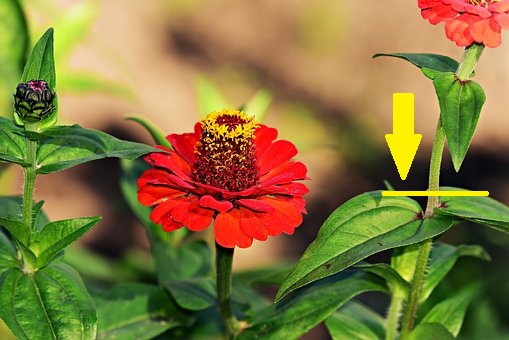Best Annuals for a Cutting Garden
Enjoy flower bouquets in your home all season by growing an annual cutting garden. A cutting garden of annuals gives you flowers you can enjoy all season, inside and out.
Sometimes we are reluctant to cut flowers from the outdoor beds, because we want them to maintain the fullest display possible. The solution – a garden grown just to supply flowers for cutting. This can be a small patch off to the side, or rows set aside in another bed such as the vegetable or herb garden. Or your annual cutting garden could be your whole back yard if you choose!
Not all cut flowers need to have long stems for vases. Small decorative containers such as teapots or tea cups can be charming when filled with dianthus, pansies, nasturtium or sweet peas. You can also use them to create dried flower arrangements, wreaths or holiday decorations.
There is a special feel when you are choosing bouquet flowers from plants you have grown yourself. You become aware of the fine details of a flower or a leaf that might not otherwise have been noticed from a garden view. When you bring a vase of flowers you grew into your living space, you bring the essence of that flower into your home with you.
There are seed packets made just for cutting gardens, and will provide a nice mix of colors and types. Look for cutting garden or wildflower garden mixes for a variety of delightful flowers. Likewise, butterfly, bee or hummingbird mixes typically contain many types of annual flowers that work well as cut flowers too. Mixes are fun because you don’t know what the flower shape or color will be until it finally opens.
If you prefer a more formal look or only want specific colors and types of flowers, choose individual seed packs of those colors.

Best annuals for cutting gardens
While most are reliable and resilient plants, not all annuals are suited for cutting and reproducing stems that will produce additional buds. Best annuals for cutting will bloom prolifically and continue to produce additional stems and buds all season.
Additionally, not all annuals are suited for lasting in a container indoors. Best annuals for cutting will have stems that take up water sufficiently so they can last in a container.
Here are some of the easiest annuals to grow that will make beautiful flower bouquets all season.
African Daisy
Baby’s Breath
Bachelors Buttons
Calendula
Candytuft
China Aster
Coreopsis
Corn Poppy
Cosmos
Dianthus
Gaillardia
Gomphrena
Godetia
Larkspur
Marigold
Nasturtium
Nicotiana
Pansy
Scabiosa
Snapdragon
Statice
Strawflower
Sunflower
Sweet Pea
Sweet William
Zinnia
Designing a cutting garden
Do you want rows or a square plot of flowers just for the utilitarian purpose of harvesting flowers, or do you want them to be a part of the artistic free-form design of the garden? Imagine the space from different viewpoints filled with flowers.
Take pictures and if you have the availability to put the picture into a software program that allows you to freeform sketch you can experiment with that. Many of my design ideas developed from playing with design software and it’s a lot of fun. A simple method would be to use Microsoft Paint or similar.
If you don’t have room for a separate garden, you can intermingle annuals with your other planting. They make great fillers around perennials that have completed blooming and will brighten open spots late in the season. Annuals also make great plants for container gardening. Place pots on dollies and you can move them around and change up the display throughout the season.
You can choose to do anything and the more you experiment the more you will find what works best for you. Since they are annuals there is no concern about dealing with a mistake long-term.
Site selection for growing annuals
Most annuals prefer sunny locations and generally tolerate heat well. While they also tolerate drought generally well, you will get more flower production by seeing that they get moisture during dry spells. Follow seed packet directions for best results.
Choose a location that allows easy access to the plants since you will be cutting them often. If you are planting between or near perennials, leave room for growth vertically and horizontally. Those perennials that are only a few inches out of the ground now are going to expand in size by the middle of summer. Leaves on trees or bushes will fill out and create shade. Plan ahead for growth to come so annuals aren’t crowded or shaded by other plants.
When planning the layout, place the tallest flowers at the rear of the bed, mid-size plants in the center, and shorter varieties in front so that all are easily accessible. Be sure to space plants according to the recommendation on the seed packet to account for their mature sizes.
Soil preparation for annuals
Well prepared soil will greatly support healthy plants and flower production. Adding organic matter before planting provides nutrients, helps moisture retention and seed germination. Break down any clumps of dirt and rake the area smooth. Follow seed packet directions for planting.
Compacted Clay or excessively rocky soils reduce germination rates and make it difficult for annuals to get started. To support healthy robust plants that will provide an abundance of blooms, amend clay soil with a 2-3” layer of compost. This will provide the right medium to support germination, moisture levels and growth. Amending soils early in the season or the prior fall is ideal for prepping your annual cutting garden.
Clear the space and remove weeds first. Trying to remove weeds around seedlings risks pulling them out with the weed. Weeds are strong and have vast root systems under the soil. Seedling roots get tangled in them and can be pulled out with the weed. If you have a small seedling that has a hearty weed growing next to it, cut the weed off at ground level until the annual can develop enough strength to hold its own, then remove the weed at a later date.
If you are making a formal bed for your annuals, or want them growing only in a particular area, define the area before planting seeds. String tied to stakes or branches, or even a hose temporarily laid on the ground to define the edge is all you need.
Some annual flowers can be sown indoors before your last frost date. Find when to plant seeds indoors for varieties. Check the seed packet for sowing information. Some annuals do better direct sown into the garden rather than being transplanted. To ensure a steady supply of flowers for cutting, employ succession planting by sowing or planting more seeds or seedlings every two weeks.
Maintaining the annual flower garden
Do not over-fertilize the plants as they grow or you could promote more lush green foliage growth than flower buds. An application of fertilizer in the soil when first planted should be sufficient. Another application of annual plant fertilizer mid-season is acceptable if the plants appear to need a boost.
Some plants may require staking, such as sunflowers or bachelor buttons. Plants that fall over and are laying on the ground will turn upward towards the sun, but flower production will be reduced and stems will be bent unnaturally for cutting.
Cutting stems for bouquets acts as deadheading, keeping the plant from going to seed. New branches, buds and flowers will keep forming as you keep cutting stems. Remove spent buds before they go to seed or your flower production will be severely stunted.
Cutting annual flowers
You can cut flowers any time of day, but it’s most ideal in the early morning or late in the afternoon.
Take a container filled with water with you when you gather flowers.
Select flowers in bud as well as in early bloom. Flowers in different stages of bloom provide more variety than when they’re all at the same stage. Flowers will continue to open in the vase, drawing water up their stems just as if they were still on the plant.

Make your cut just above a set of leaves. Often new growth will start from this area, making a new stem that will produce more buds.
Use sharp cutters that cut the stem and don’t squeeze or smash it. Submerge stems in the container of water after cutting. Bring them indoors right away so they are not in the heat.
Before putting into final container, submerge stems in water and recut the ends at 45 degree angle. Remove any foliage that will be under the water when in the container. Foliage in the water quickly rots and fouls the water.
Change water daily and recut ends up to a fresh spot on the stem if they appear to be deteriorating.
Check the garden again for new flowers that are ready to be cut!

